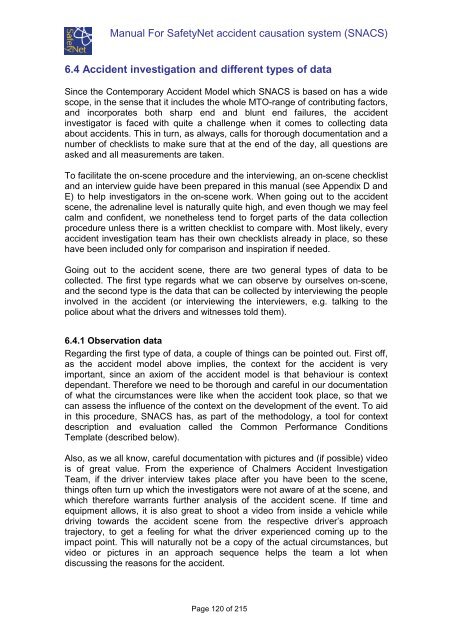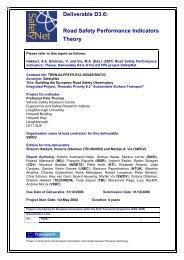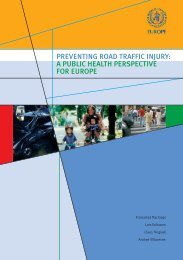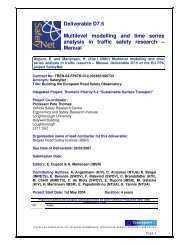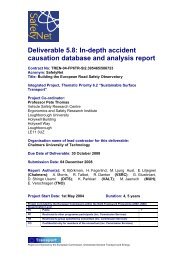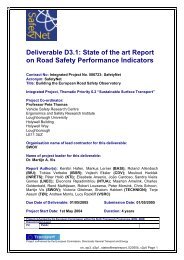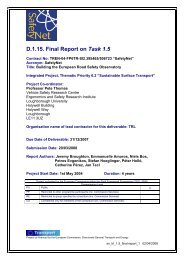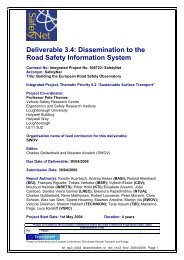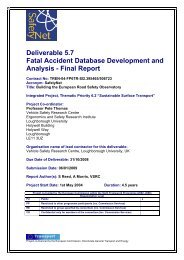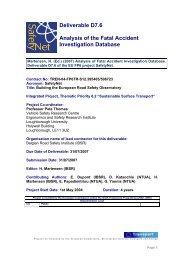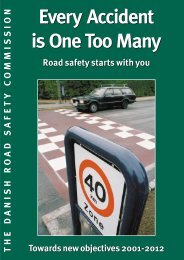Glossary of Data Variables for Fatal and accident causation ... - ERSO
Glossary of Data Variables for Fatal and accident causation ... - ERSO
Glossary of Data Variables for Fatal and accident causation ... - ERSO
Create successful ePaper yourself
Turn your PDF publications into a flip-book with our unique Google optimized e-Paper software.
Manual For SafetyNet <strong>accident</strong> <strong>causation</strong> system (SNACS)<br />
6.4 Accident investigation <strong>and</strong> different types <strong>of</strong> data<br />
Since the Contemporary Accident Model which SNACS is based on has a wide<br />
scope, in the sense that it includes the whole MTO-range <strong>of</strong> contributing factors,<br />
<strong>and</strong> incorporates both sharp end <strong>and</strong> blunt end failures, the <strong>accident</strong><br />
investigator is faced with quite a challenge when it comes to collecting data<br />
about <strong>accident</strong>s. This in turn, as always, calls <strong>for</strong> thorough documentation <strong>and</strong> a<br />
number <strong>of</strong> checklists to make sure that at the end <strong>of</strong> the day, all questions are<br />
asked <strong>and</strong> all measurements are taken.<br />
To facilitate the on-scene procedure <strong>and</strong> the interviewing, an on-scene checklist<br />
<strong>and</strong> an interview guide have been prepared in this manual (see Appendix D <strong>and</strong><br />
E) to help investigators in the on-scene work. When going out to the <strong>accident</strong><br />
scene, the adrenaline level is naturally quite high, <strong>and</strong> even though we may feel<br />
calm <strong>and</strong> confident, we nonetheless tend to <strong>for</strong>get parts <strong>of</strong> the data collection<br />
procedure unless there is a written checklist to compare with. Most likely, every<br />
<strong>accident</strong> investigation team has their own checklists already in place, so these<br />
have been included only <strong>for</strong> comparison <strong>and</strong> inspiration if needed.<br />
Going out to the <strong>accident</strong> scene, there are two general types <strong>of</strong> data to be<br />
collected. The first type regards what we can observe by ourselves on-scene,<br />
<strong>and</strong> the second type is the data that can be collected by interviewing the people<br />
involved in the <strong>accident</strong> (or interviewing the interviewers, e.g. talking to the<br />
police about what the drivers <strong>and</strong> witnesses told them).<br />
6.4.1 Observation data<br />
Regarding the first type <strong>of</strong> data, a couple <strong>of</strong> things can be pointed out. First <strong>of</strong>f,<br />
as the <strong>accident</strong> model above implies, the context <strong>for</strong> the <strong>accident</strong> is very<br />
important, since an axiom <strong>of</strong> the <strong>accident</strong> model is that behaviour is context<br />
dependant. There<strong>for</strong>e we need to be thorough <strong>and</strong> careful in our documentation<br />
<strong>of</strong> what the circumstances were like when the <strong>accident</strong> took place, so that we<br />
can assess the influence <strong>of</strong> the context on the development <strong>of</strong> the event. To aid<br />
in this procedure, SNACS has, as part <strong>of</strong> the methodology, a tool <strong>for</strong> context<br />
description <strong>and</strong> evaluation called the Common Per<strong>for</strong>mance Conditions<br />
Template (described below).<br />
Also, as we all know, careful documentation with pictures <strong>and</strong> (if possible) video<br />
is <strong>of</strong> great value. From the experience <strong>of</strong> Chalmers Accident Investigation<br />
Team, if the driver interview takes place after you have been to the scene,<br />
things <strong>of</strong>ten turn up which the investigators were not aware <strong>of</strong> at the scene, <strong>and</strong><br />
which there<strong>for</strong>e warrants further analysis <strong>of</strong> the <strong>accident</strong> scene. If time <strong>and</strong><br />
equipment allows, it is also great to shoot a video from inside a vehicle while<br />
driving towards the <strong>accident</strong> scene from the respective driver’s approach<br />
trajectory, to get a feeling <strong>for</strong> what the driver experienced coming up to the<br />
impact point. This will naturally not be a copy <strong>of</strong> the actual circumstances, but<br />
video or pictures in an approach sequence helps the team a lot when<br />
discussing the reasons <strong>for</strong> the <strong>accident</strong>.<br />
Page 120 <strong>of</strong> 215


